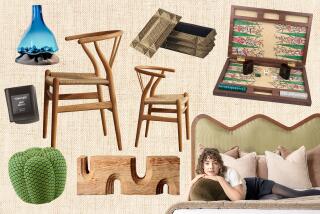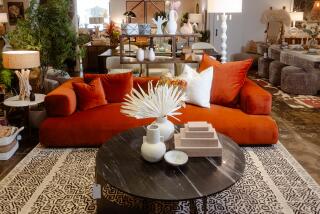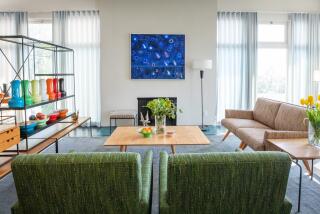FURNISHINGS : Get Off Your Cornice Box and Learn to Talk Just Like an ASID
If an interior designer says he or she is thinking about sponging your walls, is it time to get out the soap and water?
If you’re told to consider a girandole, are you being asked to dance?
And you may know what a chaise lounge or an armoire is, but what about a lambrequin or a cornice box?
As with other professions, the interior design world has its own lingo. Specialized words seep into a designer’s conversation as different fashions come in and out of vogue.
Sometimes the list of “code words” can seem endless, especially “with some furniture types,” said Jason Titus of Johnson & Titus Interior Design of Irvine. “French furniture, for example, is very elaborate and detailed. Every type of table and chair has a name.”
However, interior design has fewer code words than many other professions, Titus said, because “it’s important for an interior designer to be able to communicate with the client.”
Still, there are some specific words that seem to be part of the ‘90s home design language. The following words and abbreviations are often tossed around by Orange County interior designers. Knowing the lingo won’t make you an expert, but it might help you sound like one.
ASID (American Society of Interior Designers): The oldest and largest organization of interior designers, the ASID is a leading advocate of educational and professional standards. Members have to meet specific experience and educational requirements, including passing an examination administered by the National Council for Interior Design Qualification, also called the NCIDQ exam.
C hinoiserie: Reflecting Chinese designs and motifs, this decorative style is often used with fabric and furniture.
“It’s a European piece of furniture, such as Chippendale, done with Chinese flourishes, or toile with Chinese figures and buildings instead of French milkmaids,” Titus explained.
“Chinoiserie mixes well with contemporary furnishings, French styling and the traditional European look. It goes well with everything.”
Chintz: Having its derivation in India, chintz is a printed fabric featuring a pattern printed on a plain cotton background. Chintz is the name for this fabric when its finish is dull. When the finish is shiny, it’s simply called “polished cotton.”
“Chintz can be found in many colors and designs,” Titus said.
COM: This stands for “customer’s own material” and often is used in ordering furniture when the customer is supplying the material rather than using the manufacturer’s fabric.
“Sometimes the customer may say, ‘I don’t like this fabric,’ ” Titus said. “The interior designer then says, ‘That’s OK. We can do it COM.’ ”
Some similar abbreviations that are often tossed around include COG (customer’s own goods) and COL (customer’s own leather).
Cornice box: A window-finishing treatment, this design detail is an unupholstered box with fabric. The drapery hangs behind the cornice box.
“It’s a traditional treatment that can be quite elaborate, with many trims, fabrics and layers,” Titus said. “The fabric is absolutely smooth and tight with no wrinkles in it.”
Drapery: Here is just a little clarification about this word to keep you from committing a design faux pas. Drape, as well as drapes, is a verb, as to drape a shawl over a piano. Drapery, on the other hand, is a noun, referring to the fabric that is affixed and hanging above a window.
“People often substitute drape or drapes for the word drapery, but it’s not the correct term,” Titus explained.
FIDER (Foundation for Interior Design Education Research): This group certifies certain schools to prepare a student for passing the NCIDQ exam, according to Jackie Jacobson, owner of Creative Dimensions of Laguna Beach and a professional consultant to the UC Irvine extension environmental and interior certificate program. “If a school has the FIDER qualification, you can be sure that it meets the needs for professional interior design education.”
Girandole: Although this French word may sound like the name of a dance, it refers to a branching chandelier or wall mirror to which candle brackets are attached, Jacobson said.
IBD (Institute of Business Designers): This is an organization of interior designers that do strictly commercial interior design. Members have to do a certain percentage of business work to join the organization, explained Walter Nutting, owner of Costa Mesa-based Water Nutting Associates Inc.
Inner-lined drapery: This drapery features a layer of flannel between the lining and the drapery fabric.
“The layer adds a certain elegance,” Titus said. “It gives a look of weight, which for some fabrics is important.”
ISID (International Society of Interior Design): This Los Angeles-based society for interior design professionals includes members from North America, Mexico, Europe and Asia.
Lambrequin: This is a fabric treatment often used in traditional window settings. Draperies are hung behind the lambrequin, which is an elaborate soft cornice or window treatment at the top and sides of the window.
A lambrequin is not upholstered and has an elaborate look, according to Titus.
“The beauty of a lambrequin is that it gives that old rich look that you don’t get with a cornice box,” he said.
Lined drapery: Lined drapery is exactly what it sounds like--drapery fabric with a lining.
NCIDQ (National Council for Interior Design Qualification): The NCIDQ gives a two-day examination that all designers must take to be recognized by their peers as interior design professionals, said Jacobson.
Sponging: Sponging is a popular textural technique. An artist literally sponges paint on a painted wall to add depth and dimension to a flat surface. Sometimes three or four colors are used, and the look can range from traditional to very modern.
R agging: Similar to sponging, ragging is exactly what the term sounds like. An artist uses a rag to put paint on a wall. The result is a heavy texture or rough plaster look.
Stenciling: An old-time designer technique, stenciling is finding new directions in the ‘90s. Simply, a pattern is applied to a surface using a stencil in a repeated pattern.
You’re probably familiar with the stenciling of walls to give the look of wallpaper. However, stenciling is now being done on all kinds of surfaces, including floors, according to Nutting. For example, a floor can be stenciled to look like an area rug.
Toile: This term refers to a French chintz that features a pastoral scene printed on a plain cotton.
“A toile print can be multicolored but often is just one color,” Titus said. “The print is always classical-looking, with scenes such as women in courtyard-styled dress feeding sheep, a milkmaid with a cow, etc.”
Trompe L’oeil: This is a decorative painting technique that is becoming a popular design addition to many ‘90s homes. An artist actually does a painting on a flat wall surface. The term trompe l’oeil literally means “to deceive the eye.”
“The painting introduces some dimension or depth,” Nutting said. “It could be a painting of a window, plants or a garden. The trick is to make an enclosed space look as if it’s opened up.”


